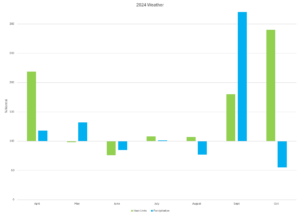Section Title
Corn Starter Phosphorous-Eastern
- Corn
Region
- Eastern
Background & Info
Research from Johnston et al. (2006) determined that 25% of fields are rated low to very low in soil P and cannot supply adequate phosphorus for a corn crop. Starter P is typically applied generously as a result of this data.
This project looks at the yield benefit vs. yield draw of starter P applied on high-P testing soils
Corn has high phosphorus requirements for plant development, beginning at germination. It is a favourable practice to seed-place a portion of the phosphorus blend, resulting in vigorous seedling growth and development. The remainder of the blend can be placed in a band near the seed row, though some grain corn farmers have adopted a split application process in-crop.
Starter phosphorus increases early-season biomass and plant height when measured at V4 and V7, respectively (Rogalsky, 2016). In the same research, silking date was 2–7 days earlier in starter-P treatments than untreated checks.
Result
Only one site showed a significant decrease in yield when no phosphorous was applied.
Starter phosphorus applications in fields with high residual-P did not provide an economical boost in grain corn yield in any sites.

